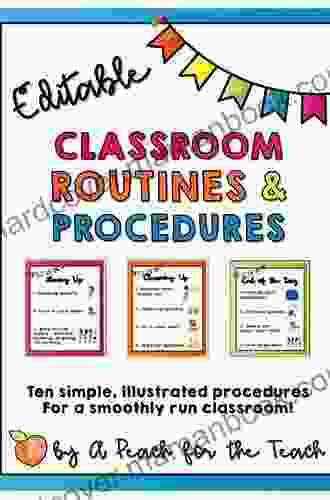Unlocking Mathematical Understanding: A Comprehensive Guide to Mathematical Imagining Routines for Secondary Classrooms

In the dynamic landscape of secondary math education, fostering mathematical thinking and creativity is paramount. Mathematical Imagining Routines (MIRs) emerge as a groundbreaking teaching strategy that empowers students to construct mental images, engage in mathematical reasoning, and unlock a deeper understanding of mathematical concepts.
5 out of 5
| Language | : | English |
| File size | : | 8455 KB |
| Text-to-Speech | : | Enabled |
| Enhanced typesetting | : | Enabled |
| Word Wise | : | Enabled |
| Print length | : | 333 pages |
| Screen Reader | : | Supported |
This comprehensive guide unravels the transformative power of MIRs, providing educators with a roadmap to implement these routines effectively. By exploring their benefits, understanding their implementation strategies, and delving into real-world examples, you will gain invaluable insights into enhancing your students' mathematical journey.
Benefits of Mathematical Imagining Routines
- Bolstering Mathematical Thinking: MIRs nurture students' ability to construct mental images, visualize mathematical concepts, and engage in critical thinking.
- Fostering Creativity: By encouraging students to imagine and explore mathematical situations, MIRs cultivate their creativity and problem-solving skills.
- Enhancing Conceptual Understanding: MIRs provide students with a tangible connection to abstract mathematical ideas, deepening their comprehension and retention.
- Developing Mathematical Reasoning: Through structured discussions and explorations, MIRs promote logical reasoning, justification of ideas, and the development of mathematical arguments.
- Building Confidence: MIRs create a supportive learning environment where students feel comfortable sharing their ideas and taking risks in their mathematical explorations.
Implementation Strategies for Mathematical Imagining Routines
To effectively implement MIRs in secondary classrooms, educators can follow these key steps:
- Introduce the Routine: Begin by introducing the MIR to students, clearly explaining its purpose and benefits.
- Establish Ground Rules: Create a classroom culture that encourages active participation, respectful discussions, and a willingness to explore different perspectives.
- Pose the Problem: Present students with a mathematical problem or situation that lends itself to mental imagery.
- Guide the Visualization: Prompt students to close their eyes and visualize the problem, using specific language and sensory details to enhance their mental representations.
- Facilitate Discussion: Engage students in structured discussions, asking probing questions to elicit their observations, reflections, and mathematical reasoning.
- Connect to Mathematical Concepts: Guide students to connect their mental images to relevant mathematical concepts and principles.
- Reflect and Assess: Encourage students to reflect on their experiences with the MIR and assess their understanding of the mathematical content explored.
Real-World Examples of Mathematical Imagining Routines
To illustrate the practical application of MIRs, here are some real-world examples:
- "Number Talks": Students visualize numbers and engage in mental computations to solve math problems.
- "What's the Picture?": Students use their imaginations to create mental images of geometric shapes or algebraic equations.
- "Pattern Detective": Students identify patterns in sequences, graphs, or tables by visualizing the underlying relationships.
- "Function Factory": Students construct mental representations of functions and their graphs to understand their properties and behaviors.
- "Measurement Maze": Students visualize and estimate measurements in real-world contexts, such as calculating the area of a garden.
Mathematical Imagining Routines are a game-changer in secondary math education, equipping students with the tools to visualize, reason, and create. By embracing MIRs in your classrooms, you will ignite students' curiosity, foster their mathematical thinking, and empower them to excel in their mathematical endeavors. Remember, the journey of mathematical discovery begins with the power of imagination, and MIRs are the key to unlocking that potential.
5 out of 5
| Language | : | English |
| File size | : | 8455 KB |
| Text-to-Speech | : | Enabled |
| Enhanced typesetting | : | Enabled |
| Word Wise | : | Enabled |
| Print length | : | 333 pages |
| Screen Reader | : | Supported |
Do you want to contribute by writing guest posts on this blog?
Please contact us and send us a resume of previous articles that you have written.
 Top Book
Top Book Novel
Novel Fiction
Fiction Nonfiction
Nonfiction Literature
Literature Paperback
Paperback Hardcover
Hardcover E-book
E-book Audiobook
Audiobook Bestseller
Bestseller Classic
Classic Mystery
Mystery Thriller
Thriller Romance
Romance Fantasy
Fantasy Science Fiction
Science Fiction Biography
Biography Memoir
Memoir Autobiography
Autobiography Poetry
Poetry Drama
Drama Historical Fiction
Historical Fiction Self-help
Self-help Young Adult
Young Adult Childrens Books
Childrens Books Graphic Novel
Graphic Novel Anthology
Anthology Series
Series Encyclopedia
Encyclopedia Reference
Reference Guidebook
Guidebook Textbook
Textbook Workbook
Workbook Journal
Journal Diary
Diary Manuscript
Manuscript Folio
Folio Pulp Fiction
Pulp Fiction Short Stories
Short Stories Fairy Tales
Fairy Tales Fables
Fables Mythology
Mythology Philosophy
Philosophy Religion
Religion Spirituality
Spirituality Essays
Essays Critique
Critique Commentary
Commentary Glossary
Glossary Bibliography
Bibliography Index
Index Table of Contents
Table of Contents Preface
Preface Introduction
Introduction Foreword
Foreword Afterword
Afterword Appendices
Appendices Annotations
Annotations Footnotes
Footnotes Epilogue
Epilogue Prologue
Prologue Hannah Howell
Hannah Howell Michael R G Spiller
Michael R G Spiller Madeleine L Engle
Madeleine L Engle Bertha Alicia Alonso Castillo
Bertha Alicia Alonso Castillo R Howard Bloch
R Howard Bloch Sierra Demulder
Sierra Demulder Cat Bowser
Cat Bowser Rachel Dodman
Rachel Dodman Sarah Fragoso
Sarah Fragoso Christopher Williams
Christopher Williams Julie Rains
Julie Rains Vladimir Mayakovsky
Vladimir Mayakovsky Scott Swisher
Scott Swisher Frederick Seidel
Frederick Seidel Don K Philpot
Don K Philpot Drew Lindsay
Drew Lindsay Ed Back
Ed Back Lorhainne Eckhart
Lorhainne Eckhart David Kinch
David Kinch Jesse Szewczyk
Jesse Szewczyk
Light bulbAdvertise smarter! Our strategic ad space ensures maximum exposure. Reserve your spot today!
 Robert ReedFollow ·2.6k
Robert ReedFollow ·2.6k Beau CarterFollow ·3.9k
Beau CarterFollow ·3.9k Kenneth ParkerFollow ·4.9k
Kenneth ParkerFollow ·4.9k Art MitchellFollow ·15.2k
Art MitchellFollow ·15.2k Arthur Conan DoyleFollow ·16.3k
Arthur Conan DoyleFollow ·16.3k William ShakespeareFollow ·7.3k
William ShakespeareFollow ·7.3k Joseph ConradFollow ·13.3k
Joseph ConradFollow ·13.3k Donovan CarterFollow ·12.8k
Donovan CarterFollow ·12.8k

 Eugene Powell
Eugene PowellComplete Guide to Using Yoga With Kids: Benefits, Tips,...
Yoga is an ancient practice that has been...

 Benji Powell
Benji PowellHow to Make $000 Per Week on Craigslist
Are you looking for a way to make extra money...

 Gabriel Garcia Marquez
Gabriel Garcia MarquezGrocery Row Gardening: The Exciting New Permaculture...
Kick-start your gardening journey with the...

 Hayden Mitchell
Hayden MitchellUnveiling the Gripping World of Winterwood: Ben Hood...
In the annals of crime thrillers, the...

 E.M. Forster
E.M. ForsterThe Financial Advisor Guide To Managing and Investing...
As a financial...

 Lee Simmons
Lee SimmonsIn My Shoes Memoir: A Poignant Journey of Resilience,...
In the tapestry of life, adversity often...
5 out of 5
| Language | : | English |
| File size | : | 8455 KB |
| Text-to-Speech | : | Enabled |
| Enhanced typesetting | : | Enabled |
| Word Wise | : | Enabled |
| Print length | : | 333 pages |
| Screen Reader | : | Supported |












